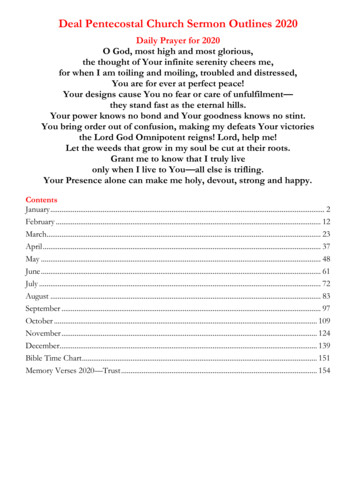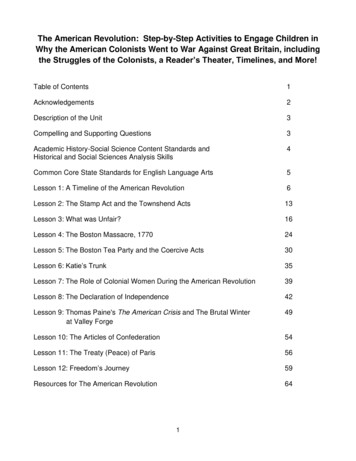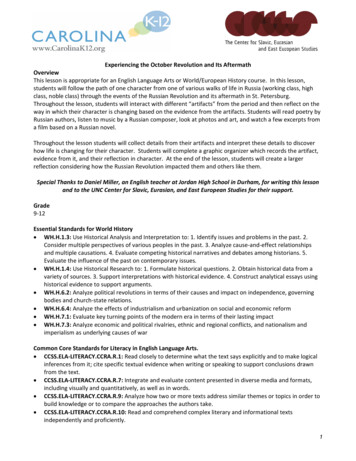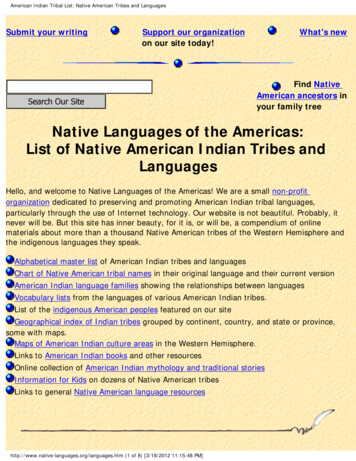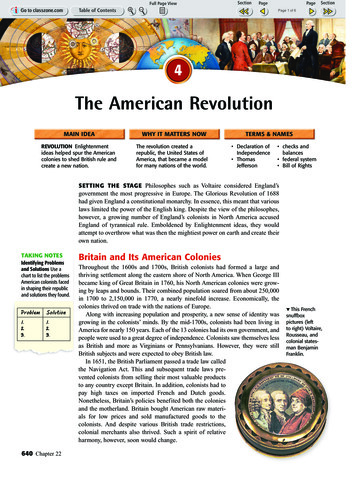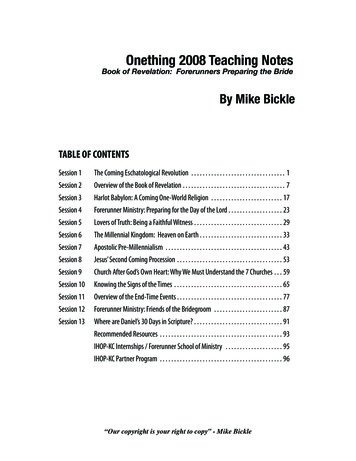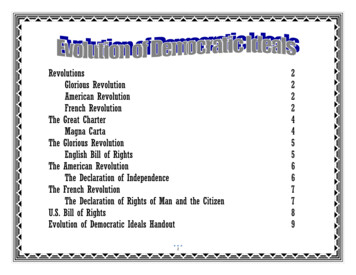
Transcription
RevolutionsGlorious RevolutionAmerican RevolutionFrench RevolutionThe Great CharterMagna CartaThe Glorious RevolutionEnglish Bill of RightsThe American RevolutionThe Declaration of IndependenceThe French RevolutionThe Declaration of Rights of Man and the CitizenU.S. Bill of RightsEvolution of Democratic Ideals Handout122224455667789
REVOLUTIONSGlorious Revolution of 1688The Glorious Revolution, the AmericanRevolution, and the French Revolution hadfar-reaching consequences as theychallenged the institutions that shaped thepolitical structure of the world. Eachattempted to establish democratic principlesof government, including limiting the powerof the government and extending rights tothe governed. Although each revolutionoccurred in a different time and place, allthree were based on the ideas thatgovernment derives its power from thepeople it governs, and government exists toprotect its citizens who have certain rightsthat cannot be denied. The GloriousRevolution, American Revolution, andFrench Revolution had enduring effectsworldwide on political expectations for self2
American Revolution of 1775The French Revolution of 1789government and individual liberty.Several essential political documentswere created at critical times in historythat paralleled the ideas that drovethese revolutions. There were fivedocuments written between 1215 to1791 with the intent to guaranteenumerous rights for their citizens.3
THE GREAT CHARTERThe English Magna Carta (1215) established the principle that no one, including theking, was above the law. The abuses by King John caused a revolt by nobles who forcedthe king to recognizethe rights of noblemen.The Magna Carta,otherwise known as theGreat Charter,eventually came toprotect the interests ofother social classes aswell. As a result, thedocument was regardedas a guarantee ofcertain rights. TheMagna Cartaestablished theprinciples of the rule oflaw, limitedgovernment, and dueprocess of law. It alsoguaranteed individualrights to the nobility.4
THE GLORIOUS REVOLUTION AND ENGLISH BILL OF RIGHTSThe Glorious Revolution (1688) brought the first bill ofrights to the English people by the new monarchs, Williamand Mary of Orange. The document begins with a list ofgrievances against the exiled King James II. It justifies boththe right to depose the king and details the rights that mustbe protected by the new sovereigns. This document ensuredthe superiority of Parliament over the monarchy whilespelling out basic rights and freedoms. The English Bill ofRights (1689) extended individual liberties and due process oflaw to the nobility. The English Bill of Rights would be amodel for future documents such as the Declaration ofIndependence and the U.S. Bill of Rights.5
THE AMERICAN REVOLUTION AND DECLARATION OF INDEPENDENCEThe American Revolution (1775-1783)showed the world that rebellion against apowerful monarchy was possible. The ideasof the Enlightenment inspired the Americancolonists to demand the rights granted tothe English citizens. Thomas Jefferson'sDeclaration of Independence of 1776claimed that unalienable rights were thefoundation of all government, and hejustified American resistance to English rulein these terms. The Declaration ofIndependence is also important because itadvocated the principle of the consent ofthe governed. Jefferson's Declaration ofIndependence had an immediate influenceon the French people at this time.6
THE FRENCH REVOLUTION AND DECLARATION OF RIGHTS OF MAN AND THE CITIZENThe French Revolution against King Louis XVI began when the king clashed withthe Estates-General, an assembly similar toParliament. The Estates-General wrote itsDeclaration of the Rights of Man and theCitizen (1789) based heavily on theAmerican Declaration. The Assembly adoptedthis charter of basic liberties. The Frenchdeclaration extended individual liberties,consent of the governed, and protected theprinciple of due process of the law.7
U.S. BILL OF RIGHTSFinally, the U.S. Bill of Rights (1791) responded to earlier ideas about therelationship between individuals and their governments. The framers of the U.S.Constitution added the first tenamendments to the Constitution, known asthe U.S. Bill of Rights, to limit the powersof the federal government. The ideasoutlined in the English Bill of Rights werewritten into the U.S. Bill of Rightsguaranteeing them to the citizens in theUnited States. The U.S. Bill of Rightsextended and protected the principles ofindividual liberties and due process oflaw.8
The Evolution of Democratic Ideals HandoutA. List the three revolutions discussed in the reading.1.2.3.B. List the five documents that laid the foundation for the development of modern day democracy and they year eachdocument was written.1.4.2.5.3.C. Place the five documents on the timeline in chronological order and explain the significance in the space below thedocument.D. Which document or documents influenced the following, select the corresponding letters?French DeclarationDeclaration ofMagna CartaEnglish Bill of Rightsof Rights of Man andIndependencethe CitizenABCDU.S. Bill of RightsE1. English Bill of Rights:3. French Declaration of Rights of Man and the Citizen:2. Declaration of Independence:4. U.S. Bill of Rights:9
The French Revolution against King Louis XVI began when the king clashed with the Estates-General, an assembly similar to Parliament. The Estates-General wrote its Declaration of the Rights of Man and the Citizen (1789) based heavily on the American Declaration. The Assembly adopted this charter of basic liberties. The French

